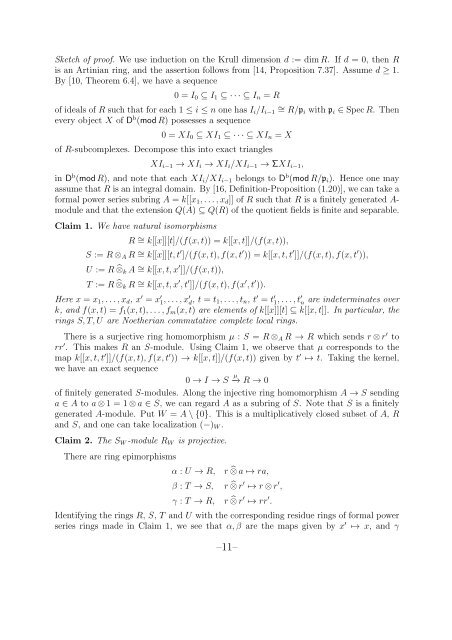Takuma Aihara
Takuma Aihara
Takuma Aihara
Create successful ePaper yourself
Turn your PDF publications into a flip-book with our unique Google optimized e-Paper software.
Sketch of proof. We use induction on the Krull dimension d := dim R. If d = 0, then Ris an Artinian ring, and the assertion follows from [14, Proposition 7.37]. Assume d ≥ 1.By [10, Theorem 6.4], we have a sequence0 = I 0 ⊆ I 1 ⊆ · · · ⊆ I n = Rof ideals of R such that for each 1 ≤ i ≤ n one has I i /I i−1∼ = R/pi with p i ∈ Spec R. Thenevery object X of D b (mod R) possesses a sequence0 = XI 0 ⊆ XI 1 ⊆ · · · ⊆ XI n = Xof R-subcomplexes. Decompose this into exact trianglesXI i−1 → XI i → XI i /XI i−1 → ΣXI i−1 ,in D b (mod R), and note that each XI i /XI i−1 belongs to D b (mod R/p i ). Hence one mayassume that R is an integral domain. By [16, Definition-Proposition (1.20)], we can take aformal power series subring A = k[[x 1 , . . . , x d ]] of R such that R is a finitely generated A-module and that the extension Q(A) ⊆ Q(R) of the quotient fields is finite and separable.Claim 1. We have natural isomorphismsR ∼ = k[[x]][t]/(f(x, t)) = k[[x, t]]/(f(x, t)),S := R ⊗ A R ∼ = k[[x]][t, t ′ ]/(f(x, t), f(x, t ′ )) = k[[x, t, t ′ ]]/(f(x, t), f(x, t ′ )),U := R ̂⊗ k A ∼ = k[[x, t, x ′ ]]/(f(x, t)),T := R ̂⊗ k R ∼ = k[[x, t, x ′ , t ′ ]]/(f(x, t), f(x ′ , t ′ )).Here x = x 1 , . . . , x d , x ′ = x ′ 1, . . . , x ′ d , t = t 1, . . . , t n , t ′ = t ′ 1, . . . , t ′ n are indeterminates overk, and f(x, t) = f 1 (x, t), . . . , f m (x, t) are elements of k[[x]][t] ⊆ k[[x, t]]. In particular, therings S, T, U are Noetherian commutative complete local rings.There is a surjective ring homomorphism µ : S = R ⊗ A R → R which sends r ⊗ r ′ torr ′ . This makes R an S-module. Using Claim 1, we observe that µ corresponds to themap k[[x, t, t ′ ]]/(f(x, t), f(x, t ′ )) → k[[x, t]]/(f(x, t)) given by t ′ ↦→ t. Taking the kernel,we have an exact sequence0 → I → S µ −→ R → 0of finitely generated S-modules. Along the injective ring homomorphism A → S sendinga ∈ A to a ⊗ 1 = 1 ⊗ a ∈ S, we can regard A as a subring of S. Note that S is a finitelygenerated A-module. Put W = A \ {0}. This is a multiplicatively closed subset of A, Rand S, and one can take localization (−) W .Claim 2. The S W -module R W is projective.There are ring epimorphismsα : U → R,r ̂⊗ a ↦→ ra,β : T → S, r ̂⊗ r ′ ↦→ r ⊗ r ′ ,γ : T → R, r ̂⊗ r ′ ↦→ rr ′ .Identifying the rings R, S, T and U with the corresponding residue rings of formal powerseries rings made in Claim 1, we see that α, β are the maps given by x ′ ↦→ x, and γ–11–















